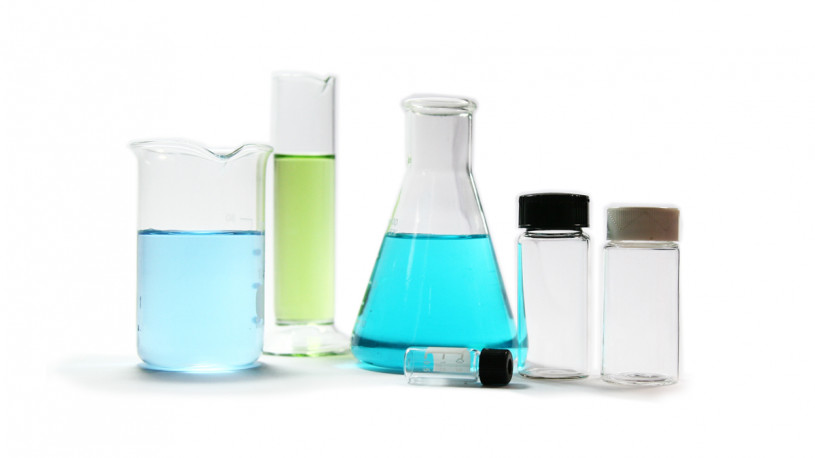-
Calls for more Safety Testing for Titanium Dioxide
 Continue Reading
Continue ReadingA recent study is calling into question the risks posed to humans from the consumption of food grade titanium dioxide. Whilst the research was unable to pinpoint specific risks, it did call for further research into the effects of TiO2 on human organs, as well as questioning if particle size can make a difference.
The study, which was published in the journal ‘Nanotoxicology’, was conducted by the Dutch National Institute for Public Health and the Environment (RIVM), and included an investigation which came in two parts, which the RIVM describes as follows:
“First, RIVM estimated the amount of titanium dioxide nanoparticles that the Dutch consumer daily ingests via food, food supplements and toothpaste. This was calculated by using measured concentrations in food products and toothpaste, which were linked to information on the intake of food products. The products contributing most to the intake of TiO2 are toothpaste (in young children only), candy, coffee creamer, fine bakery wares and sauces.
Second, RIVM performed a risk assessment by estimating the concentration of titanium dioxide nanoparticles in human liver, and subsequent comparison to the concentration in the liver of test animals for which adverse effects were found. The accumulation of particles in time was taken into account in these calculations.”
With these actions completed the research team were able to state the following, “Based on this investigation and considering the differences between man and animals and sensitive people, it appears that liver effects cannot be excluded. To gain better insight into the likelihood of effects after long-term exposure (such as via food), further research is recommended.”
Much of the concern is based around the unknown effects of TiO2 when it is consumed in different particle sizes. As the RIVM report explains, “No limit has been set for the amount of titanium dioxide that man can daily ingest. It is nowadays known that very small particles, such as nanoparticles, can behave differently from larger particles of the same chemical composition. The small particles have a relative large surface area and can therefore be reactive and may cause harmful effects. In addition, they may end up at different sites in the human body.”
Meanwhile, Dr Emma Davies reporting for ChemicalWatch recently quoted a report conducted by the Scientific Panel of the European Food Safety Authority (ANS), when she stated that, “Although food grade titanium dioxide is not considered a nanomaterial, it may contain about 3% nanoparticles, reports the ANS. It says studies show that most titanium dioxide passes through the body unchanged but that ‘a small amount’ (up to 0.1%) can be absorbed in the gut and distributed to organs.”
She continues by observing how, “The ANS was unable to set an acceptable daily intake (ADI) because of a lack of information. Additional testing on food grade titanium dioxide, such as an extended 90-day rodent study or a multi-generation or extended one-generation reproductive toxicity study (Eogrts), ‘would help to clarify possible reproductive effects and provide more comprehensive data for deriving an ADI’.
Analysis of the EFSA report into the effects of TiO2 on human health, finds that, “The Panel noted that possible adverse effects in the reproductive system were identified in some studies conducted with material which was either non-food-grade or inadequately characterised nanomaterial (i.e. not E 171). There were no such indications in the available, albeit limited, database on reproductive endpoints for the food additive (E 171).”
So it seems that while some studies have found a link between TiO2 and a negative effect on human health (mostly in the liver or reproductive organs) for now it has been deemed safe for human consumption.
That said, the versatile food additive chemical is not yet free and clear, as both reports make clear that there is little information available for analysis, and that further research is needed ‘to fill data gaps’.
However, perhaps what is most interesting from the report is the question mark remains on the importance of particle size of chemicals. As the RVIM report says, “It has become clear that nanoparticles can behave differently as compared to larger particles or soluble substances.”
And if this is the case, how certain can we be of the safety of so many other chemical food additives?
Photo credit: RVIM
-
Industrial Scale 1,4 Butanediol from Sugar is now a Reality
 Continue Reading
Continue ReadingSeptember 30th 2016 saw the official opening of the world’s first industrial bio-butanediol plant. With a feedstock based directly on sugars that are broken down by bacteria, the development marks a major step in providing an alternative to fossil fuel chemical feedstock.
Better still, the original plan was to produce 18,000 tonnes per annum capacity has been increased to 30,000 tonnes as demand for renewable polymer materials grows. Currently production is focused on producing wrapping films for fruit and vegetables that, like the products they protect, are both biodegradable and compostable. The plant will also produce 1,4 BDO for the manufacturing of coffee capsules, although the facility will produce polymer feedstock for numerous plastic products.
The new plant is run by the company Mater-Biotech, which in turn is 100% owned by Novamont, and expects to reach full production some time in 2017.
The opening was announced in a Novamont press release that explained how the plant, “Represents an investment of over €100 million. The Mater-Biotech plant in Bottrighe [70km south of Venice] will be the world’s first industrial plant dedicated to the production of bio-butanediol (BDO). It will produce 30,000 tonnes/year of low-impact BDO, with savings of more than 50% in terms of CO2 emissions, thus helping achieve a ‘low carbon society’.”
The plant was designed in collaboration with the California based firm Genomatica, which rightly boasts on its website how, “The new BDO plant uses Genomatica’s GENO BDO™ process technology to convert sugars to BDO. Genomatica’s licensed technology enables production of a bio-BDO that can be used the same way as conventional, while delivering better economics and sustainability.”
You can see more of the new plant on this YouTube video here.
It also seems that this plant will be just the first of many, as the GreenChemicalsBlog website reports that, “BASF also has a licensing deal with Genomatica for its bio-BDO process, with the potential to build up to 75 ktpa commercial plants that can be based on dextrose or sucrose for feedstock. BASF’s license agreement with Genomatica includes production of bio-BDO in North America and certain countries in Southeast Asia.”
Currently, global demand for butanediol is 1.5 million tonnes per year (with a value of €3.5 billion), but as demand for solvents, polyurethanes, polymers and plastic grows then demand for butanediol is expected to reach as much as 2.7 million by 2020. With a value of €6.5 billion, this enormous market growth may well see a similar growth in bio-butanediol facilities.
Photo credit: Novomont
-
Top 6 Tips for Managing Chemical Feedstock Price Volatility
 Continue Reading
Continue ReadingChemical feedstock price volatility is lethal. It can kill a company in a matter of weeks and destroys business models overnight.
With feedstock taking on average 60% of a chemical company’s total costs, chemical manufacturers are wary of changes to supply costs, but unfortunately for them, many of the feedstock goods have no alternative, especially in the short to medium term. As the advice website Investopedia states, “Many of the materials used as feedstock for chemical products are irreplaceable. For example, as of 2015, Dow Chemical devotes about 40% of its operating expenses to petrochemicals needed to create its chemical products. A substantial part of these costs consists of commodities with costs that are prone to fluctuate greatly with the broader global economy as energy prices and consumer demand change.”
If a massive chemical industry player like Dow Chemical can fall victim to feedstock price volatility, then it must be expected that the rest of the industry is also liable to its influence.
Helpfully, industrial chemical manufacturers and traders can find a great deal of support on how to manage feedstock price volatility. But with experts from economics, retail, wholesale, psychology, chemical engineering and sales all offering suggestions, it can be difficult for a chemical producer to know how to react when suppliers prices go up overnight.
So in an attempt to condense some of this advice into a more manageable volume, and yet without wanting to over-simplify a highly complex subject, here are the top 6 tips for setting chemical prices.
1. React.
Prior to the 2014 collapse in petroleum prices, the cost of a barrel of oil had remained stable for four years, when the price collapsed many companies were slow to change strategy when cost-advantages had so clearly changed.
A recent report on the chemicals industry entitled ‘Preparing for a Volatile Environment’ by the renowned consultants McKinsey, underlines this point, stating that, “The 2014 shock has shown that many chemical companies are incapable of changing direction quickly enough to respond appropriately to oil-price shocks. The stable-oil-price environment from 2010 onward allowed many chemical-company leaders to focus their attention away from volatility management.”
2. Empower Management.
When prices are changing rapidly, speed is important when switching business strategy to limit damage. Doing this will require a series of decisions by top-management. As McKinsey consultant and analyst Chris Musso, recommends, “Assemble a senior, cross-functional decision-making team. In highly volatile environments, decisions must be made much more quickly and at higher levels than in business-as-usual periods.”
Deloitte’s report on ‘Pricing in the Chemicals Industry’ supports this approach, advising chemical companies to, “Engage your management – The commitment of top management to invest in powerful pricing programmes is crucial to the successful execution of a pricing strategy.”
3. Calculate Volatility Risk.
Before your feedstock price has gone through the roof, calculate the chance of this happening, and ask yourself, “Does the risk of this happening and its consequences outweigh the gains to be made if it doesn’t?”. Knowing the answer to this will prevent you from being exposed to feedstock price volatility unnecessarily.
As Sheng Hong, a McKinsey consultant and market strategist, stated, when he said that chemical producers, “…should take decisive action to understand what is the ‘right’ amount of risk for their business, and then eliminate undesirable risks by shifting them through contracting, financial hedging, and internal operational choices (for example, sourcing alternative feedstocks).”
4. Accept that Feedstock Volatility will Happen.
Given the increasingly rapid changes in a now global economy over the last 20 years, then future price slumps and peaks are a certainty. The wise chemical manufacturer must know that feedstock prices will change, and sometimes rapidly, and be prepared for it. As a recent report entitled ‘Responding to Oil Price Volatility in the Chemical Industry‘ by Piet de Paepe, Jason McLinn and Mark Porter for the business consultancy Bain & Company states, “Over the past decade, oil prices have gone through at least two complete cycles, and more big swings are likely in the future. Chemical producers will have to continue to make short- and mid-term plans during this time of volatile prices.”
5. Reconsider Pricing.
When feedstock prices fluctuate adversely, it may seem that the obvious reaction is to increase your sales price to counter the effect. This may not always be the right choice, but it is important that pricing policy is understood by the whole team, and that it is clear who is responsible for pricing policy.
This is a point made clear by Accenture’s analysis of chemical pricing policies, in their report ‘Chemical Pricing Strategies in a Global Market’, which states that, “There are organizational and operational challenges that must also be addressed when moving to a strategic pricing approach. It is sometimes unclear who is responsible for setting prices because there are no clear governance procedures. Even when the business unit is designated as being responsible, they may have no market information to properly assume this responsibility. In addition, there can be conflicts between the direct sales force and sales subsidiaries, or even among business units. In order to resolve these issues, the authority of each business unit and sales organization must be clearly defined, and consistent operating processes must be followed.”
6. Stay Focused on what is Important.
The last thing that any business needs is panic. So it is vital that the central goals of the business remain clear and that those goals are met first. As Chris Musso writes, “Identify value and develop action plans. Companies must rapidly translate priorities into concrete actions by identifying pockets of value at stake (for example, customers at risk of switching to other suppliers) and developing clear and specific action plans (for instance, by customer) for frontline teams to implement.”
Whatever sector of the chemical market a business operates in, it is perhaps most important to understand the inevitability of feedstock challenges.
As McKinsey advises, “Chemical companies need not necessarily fear feedstock-price volatility; in fact, the best ones will savour the opportunities it presents. With disciplined investment in organizational capabilities and agility, producers can effectively plan for, respond to, and benefit from price shocks.”
For whilst there is inherent risk in any changing business situation, there is also opportunity.
